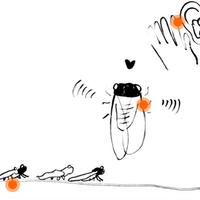
Apr 1, 2013
Lurking in the ground beneath our feet, waiting in their burrows for the first signs of spring are tens of millions of cicadas.
After 17 years, cicadas are expected to emerge and overwhelm a large swath of land from Virginia to Connecticut — climbing up trees, flying in swarms and blanketing grassy areas so they crunch underfoot.
The insect, with its sinisterly bright red eyes and black body, can grow to about an inch and a half long. Include the bug’s clear wings and that could add about 2 inches.
But what’s really notable about the cicada is its loud, unrelenting noise. To imagine what it sounds like, Jody Gangloff-Kaufmann, an urban entomologist and a senior extension associate at Cornell University, says think of a plastic water bottle. “Push the plastic back and forth, it makes a click sound,” she said. “Imagine that going really quickly.”
That’s what we could be hearing for about a month this spring when Brood II emerges. (The periodical cicadas come every 13 or 17 years, depending on the brood. Brood II takes 17 years.)
As many as one million to five million cicadas can be found per acre, according to research scientist John Cooley from the University of Connecticut, Storrs. He also runs the website Magicada. When the soil temperature reaches 64 degrees, they start to make their way out of the ground and into our world.
Radiolab is inviting armchair scientists, lovers of nature and DIY makers to help predict the emergence of cicadas by building a homemade sensor and sharing your observations.
While the periodic emergences are hard to miss because of the noise and the overwhelming numbers, it is hard to predict where and how many will actually come out because of habitat degradation.
Cicadas live in the ground, near trees. They feed off the roots of trees. And they only come out for a few weeks, during which time they will molt and then mate. The females will lay eggs that hatch and the nymphs will then burrow underground to start a new 17-year-cycle, while the adult cicadas die.
And despite their sinister appearance, Gangloff-Kaufmann says, they’re really harmless and kind of, well, hapless. “They’re bumbling cute,” she said. “Many people are afraid of them because of their size and the way they make noise. But, they can’t bite you or sting you or hurt you in any way.”
And Cooley is excited about the upcoming spectacle. “There’s nothing else like it out there. If you like insects, and large numbers of them, this is something special.”
And if you don’t, well, it should be over by August.